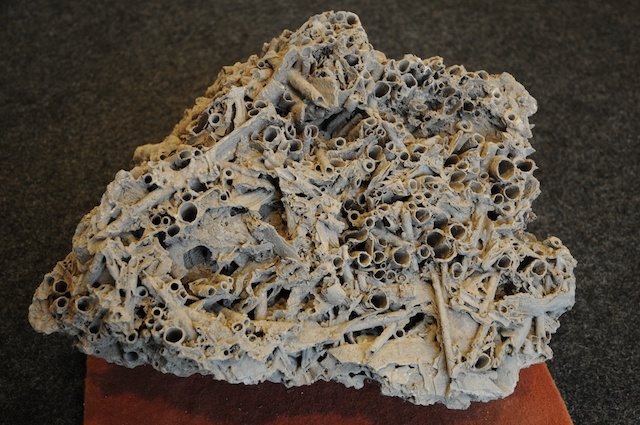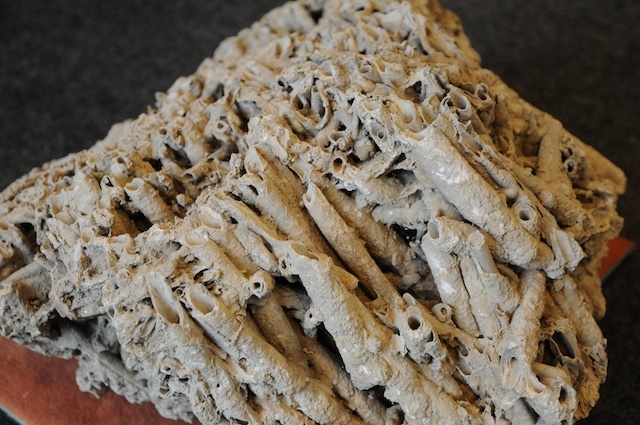Bad Laerer Piepstein EarthCache
-
Difficulty:
-

-
Terrain:
-

Size:  (not chosen)
(not chosen)
Please note Use of geocaching.com services is subject to the terms and conditions
in our disclaimer.


Deutsche Version
Der Ort Bad Laer im südlichen Landkreis Osnabrück ist überregional als Soleheilbad bekannt. Darüberhinaus hat Bad Laer aber noch ein weiteres Wahrzeichen, den sogenannten Piepstein, eine lokale Besonderheit.
Bei dem Piepstein handelt es sich um Versteinerungen von Pflanzen, die in Sinterkalken (Travertinen) eingeschlossen wurden. Es sind mit Hohlräumen durchsetzte, weniger massive Schichten Gestein inmitten von äußerst harten Lagen der besagten Sinterkalke.
Bei näherer Betrachtung erkennt man, dass diese Hohlräume häufig Querschnitte und Bruchstücke von Kalkröhren sind. Da diese Röhren oftmals wie Orgelpfeifen aufgereiht sind, hat der Volksmund diesen Stein „Piepstein“ (Pfeiffenstein) getauft.
Bei der Entstehung dieses speziellen Steins spielt die Bad Laerer Sole eine entscheidende Rolle.
Vor ca. 6000-10.000 Jahren wuchsen Schilfpflanzen und Großseggen um die Solequelle. Das Wasser, was aus den porösen Gesteinsschichten emporstieg, war sehr kalkhaltig. Dieses kalkhaltige Solewasser trat an die Oberfläche, floss in den See ein und erwärmte sich dabei, was zur Folge hatte, dass der Kalk sich aus dem Solewasser löste und sich an der Schilfpflanzen ablagerte. Dieses führte zur Verkrustung der Schilfstengel.
Das Steinvorkommen ist eine 1100 x 800 m große „Felsplatte“, dass, z.B. unter der Kirche eine Dicke von bis zu 6m erreichen kann. Der Ortskern von Bad Laer wurde auf dieser Platte errichtet.
Die Piepsteine sind sehr hart und durch ihre poröse Struktur zudem noch sehr leicht, was sie auch überregional populär als Baumaterial machte. Berühmtes Beispiel ist der Dom zu Münster, in dessen Gewölbe zu erheblichen Anteilen Bad Laerer Piepstein verbaut wurde.
Im Ortskern von Bad Laer ist noch an diversen Stellen Piepstein als verwendetes Baumaterial zu bewundern, Mauern, Häuser oder der mehr als 1000 Jahre Kirchturm der St. Marienkirche als eindrucksvolles Beispiel.
Im Heimatmuseum von Bad Laer gibt es im Rahmen einer Daueraustellung zum Piepstein enige sehr schöne Exemplare zu besichtigen, ausserdem noch eine ganze Reihe von zusätzlichen Informationen rund um den Piepstein.
Der Earthcache soll zu einem Erkundungsgang durch Bad Laer einladen, um den Piepstein zu entdecken.
Beispiele:
Kirchturm und Fassade der St. Marien Kirche
Mauer in der so genannten "Schweinegasse", Verbindung zwischen Kirchhof St. Marien und Kurpark
Gebäude Heimatmuseum
Wohnhaus in der Brinkstrasse Nr. 4
Haltet die Augen offen: Es gibt noch mehr zu sehen als nur die Beispiele und Aufgaben.
Wir wünschen viel Spaß beim Entdecken des Bad Laerer Piepsteins.
Logbedingungen:
Bitte schickt die Antworten der folgenden Aufgaben per email an uns, Ihr müsst aber keine Antwort abwarten, sondern könnt direkt loggen. Falls etwas nicht korrekt ist melden wir uns bei euch.
Aufgaben:
1. Piepsteinbrocken
Stellvertretend für die Felsplatte aus Piepstein, auf die der Ortskern von Bad Laer errichtet wurde, sucht bitte den ausgestellten Piepsteinbrocken auf (Koordinaten siehe Waypoints) und messt an der breitesten Stelle den Umfang des Steinbrockens.
Bitte ein Maßband oder eine Schnur mitbringen.
2. Kolk - Solequelle
Die Bad Laerer Sole spielt wie bereits gelernt die entscheidende Rolle bei der Entstehung des Piepsteins. Bitte begebt euch zum Kolk an der Solequelle und findet die Infotafel (siehe Waypoint).
Frage: Mit was vermischt sich das solehaltige Schichtenwasser vermutlich bei Austritt an die Oberfläche (Antwort auf Infotafel)?
3. Foto (optional)
Wer mag macht bitte ein Foto von sich und dem GPS vor dem Piepsteinbrocken und hängt es an das Log.
Wir würden uns freuen, wenn viele diese schöne, alte Earthcache Tradition mit uns weiter führten.
Quellen:
Heimatmuseum Bad Laer
Bad Laer Touristik.
H. Hiltermann, in Suderberger Hefte Nr. 6, 1985.
Achim Köpp, Neue Osnabrücker Zeitung
http://www.baufachinformation.de
Öffnungszeiten Heimatmuseum: (März bis Oktober)
Mittwochs 15:00 Uhr bis 17:00 Uhr
Sonntags 10:00 Uhr bis 12:00 Uhr
Der Eintritt ist frei


English version
The town of Bad Laer in the southern district of Osnabrück is national wide known as a brine spa. Moreover, Bad Laer has another landmark, the so-called "Piepstein", a local speciality.
The Piepstein (local travertine) are fossils of plants that were included in calc-sinter (Travertines). These are less massive layers of rock, interpersed with cavities, in the midst of very hard layers of the mentioned calc-sinter.
On a closer inspection you can see, that those cavities are often cross-sections and float-pieces of lime tubes. Since these tubes are often lined up as organ pipes, the vernacular named this stone Piepstein (pipe stone).
At the formation of this special stone the brine of Bad Laer had an essential role.
About 6000-10.000 years ago reeds and sedge grew around the brine source. The water, which rose from the porous rock layers, was very calcareous. This chalky brine water came to the surface, flowed into the lake, and it warmed up. As a result the lime dissolved from the brine water and it was deposited in the reeds. This led to the rigidity of the reed stems.
The stone deposit is a 1100 x 800 m large plate of rock, that, as for example underneath the church, can reach a thickness of up to 6m. The town of Bad Laer was built on this plate of rocks.
The local travertine are very hard and because of their porous structure also very light, which made them even national wide popular as a building material.
A famous example is the Cathedral of Münster, where a signifcant part of the the vault was build with Piepstein of Bad Laer.
In the centre of Bad Laer you can see the Piepstein as building material at several places, at walls, houses and the more than 1000 years old spire of the St. Marienkirche, as a very impressive example.
In the museum of Bad Laer you can see some very nice and impressive examples of the Piepstein, additionally there are some more information around this very special local travertine.
This Earthcache shall invite you to a round tour to explore the Piepstein in Bad Laer.
Examples:
Spire and cladding of the church St. Marien
Wall at the so called "Schweinegasse", the connection between St. Marien church and spa gardens
Building Heimatmuseum
Residential house number 4 in the Brinkstrasse
Keep your eyes open:
There's more to see than just the examples and tasks.
We wish you much fun discovering the Piepstein of Bad Laer.
How to log:
Please send the answers to the following tasks by email to us, you directly are allowed to log, you do not need to wait for an answer of us. If something is wrong, we will contact you.
Tasks:
1.The big rock of Piepstein
Representative for the plate of rock on which the centre of Bad Laer was built, please look for the arranged rock of Piepstein (see waypoints) and measure the breadth of the rock at the broadest point.
Please bring a measuring tape or a string along.
2. Scour - Brine source
As we learned the brine of Bad Laer had an essential role at the formation of this stone.
Please make your way to the scour at the brine source and find the information board (see waypoint).
Question: The bine is probably mixed up with something when discharging to the surface. With what (answer on the information board)?
3. Photograph (optional)
If you like, please take a picture of you and your GPS in front of the big rock of Piepstein (see task 1) and attach it to your log.
Would be great if many of you let this nice tradition of Earthcaches going on.
List of sources:
Heimatmuseum Bad Laer
Bad Laer Touristik.
H. Hiltermann, in Suderberger Hefte Nr. 6, 1985.
Achim Köpp, Neue Osnabrücker Zeitung
http://www.baufachinformation.de
Opening hours Heimatmuseum Bad Laer (march until october):
Wednesday 03pm - 05pm
Sunday 10am - 12am
Admission is free.


Additional Hints
(No hints available.)